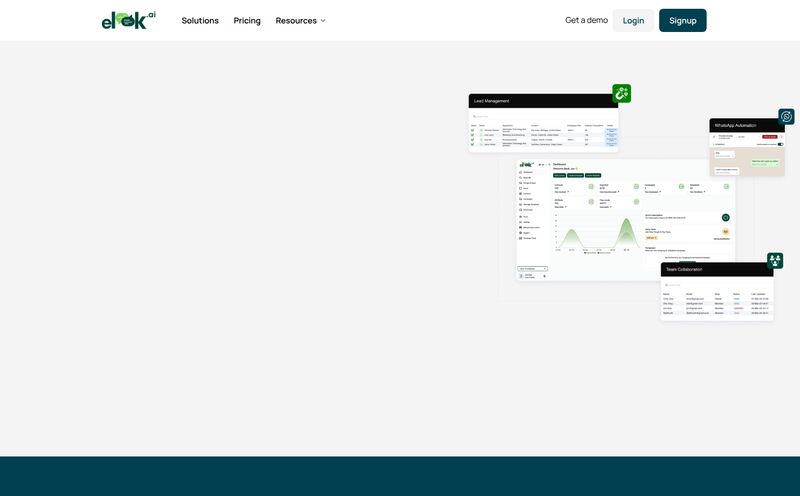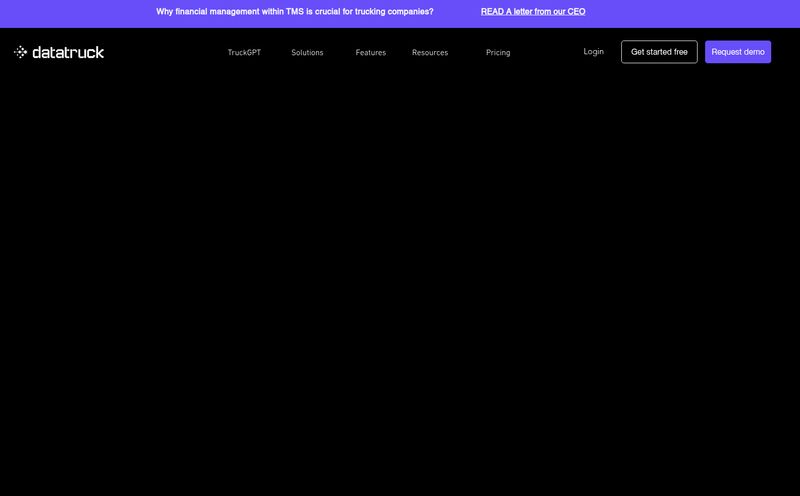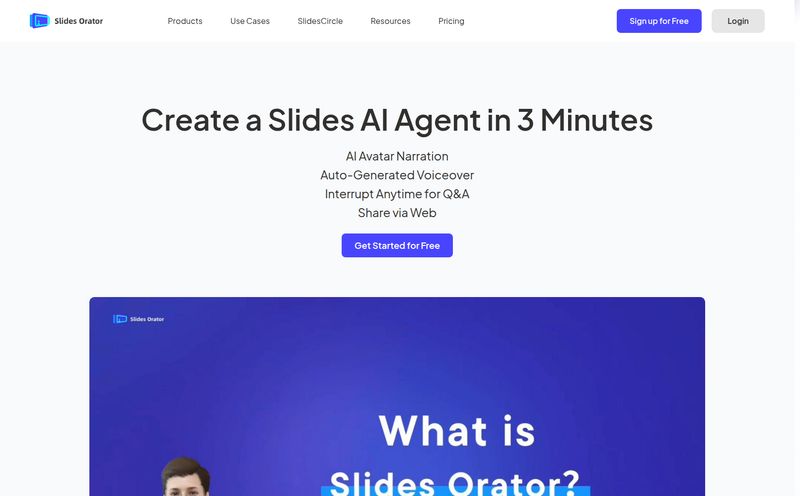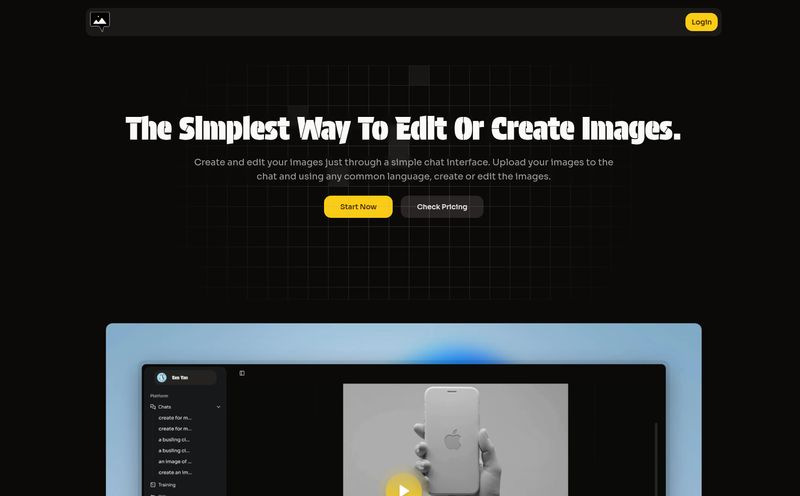I swear, if one more website chatbot asks me, “How can I help you today?” and then proceeds to offer me three canned responses that have nothing to do with my actual question, I might just throw my laptop out the window. We've all been there. You’re trying to get a simple piece of information—a tracking number, a policy detail, anything—and you're met with a digital brick wall that’s about as helpful as a screen door on a submarine.
For years, we in the SEO and digital marketing space have been told that chatbots are the future of customer engagement. And they are! But not like this. Not the dumb, scripted ones. The real future is in AI that actually knows what it's talking about. An AI that's been trained on your business, your products, your data.
It’s a problem I've grappled with for my own projects and for clients. How do you create an intelligent assistant without a team of developers and a six-figure budget? Well, I’ve been playing around with a platform called DataLang, and it’s one of the most promising answers I’ve seen in a long time. It feels less like a tool and more like a cheat code.
So What Exactly is DataLang?
At its heart, DataLang is a bridge. It connects all your scattered company information—from databases to documents to spreadsheets—and hooks it up to a powerful GPT-based AI. It acts as the ultimate translator between your messy, siloed data and a slick, conversational chatbot that you can put anywhere.
Think of it like this: You hire a brilliant new employee. Instead of spending weeks training them, you just give them a key to the company library and say, “Have at it.” That’s what DataLang does for an AI. It ingests your data and, in a shockingly short amount of time, creates an expert on your business.
The platform breaks it down into four simple steps: Set up your data source, add a data view (this is where a little SQL knowledge can come in handy, but isn't always necessary), chat with it to test it, and then share it with the world. Simple on the surface, but incredibly powerful underneath.
Connecting Your Entire Business Brain
The first thing that genuinely impressed me about DataLang was its list of data source integrations. This isn't just a tool for connecting a simple FAQ document. This is for building a real, knowledgeable assistant.
You can connect it directly to your core operational databases like Postgres, MySQL, and SQL Server. This alone is huge. Imagine a chatbot that can pull up a customer's specific order status or check inventory levels in real-time. But it doesn't stop there. It plugs right into the productivity tools so many of us live in, like Notion and Google Sheets. Got all your project info in a Notion workspace? Boom, you can now have a chatbot that answers questions about project deadlines and tasks. All your sales data in a Google Sheet? Now you can ask it, “What was our top-selling product in Q2?” and get an actual answer.
It even connects to your CRM with HubSpot, your internal files, or just scrapes a public website for its content. The flexibility is the real killer feature here. You’re not forced to reformat everything into some proprietary system. You just point DataLang at where your information already lives. This is how modern tools should work.
The Many Ways You Can Share Your New AI Assistant
Creating a smart AI is only half the battle. You need to get it in front of people. DataLang offers a few different ways to do this, catering to different needs.
- Public URL: The simplest way. You get a direct link to your chatbot. Perfect for sharing with your internal team or for specific, targeted use cases where you don't need it embedded on a site.
- Chatbot Widget: This is the big one for most marketers and business owners. With a snippet of code, you can embed your custom-trained chatbot directly onto your website. This replaces those generic, unhelpful chat bubbles with an assistant that can actually answer customer questions, generate leads, and provide support.
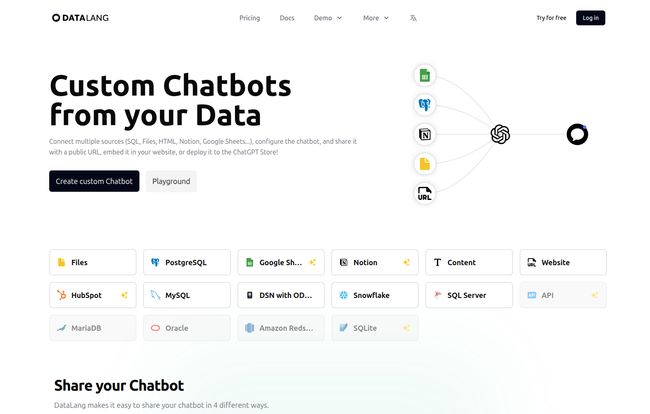
Visit DataLang
- GPT Store: Now this is very, very cool. For anyone deep in the OpenAI ecosystem, you know that creating a custom GPT with unique knowledge can be a process. DataLang allows you to configure your bot and then publish it directly to the GPT Store. This opens up a whole new world for creating specialized, monetizable, or publicly available GPTs powered by your unique data sets. It's a massive shortcut.
- API: For the tech-savvy crowd and developers, full API access means the sky's the limit. You can integrate your DataLang-powered AI into any application, workflow, or custom front-end you can dream up.
Let's Talk Turkey: DataLang Pricing
Alright, let's get to the question on everyone's mind: how much does this magic cost? The pricing structure is pretty straightforward, with a plan for just about every level of user. It’s a credit-based system, which means you pay for usage, so that's something to keep in mind.
| Plan | Price | Key Features | Best For |
|---|---|---|---|
| Free | $0/month | 1 user, 1 data source, 100 credits | Testing the platform, personal projects |
| Basic | $19/month | 2 users, 10 data sources, 1,000 credits/month | Solopreneurs or very small teams |
| Pro | $49/month | 6 users, 50 data sources, 3,000 credits/month, No branding, Basic support | Small to medium businesses, serious users |
| Business | $399/month | 12 users, 1,000 data sources, 20,000 credits/month, Priority support | Larger teams and businesses with high traffic |
The Free Plan Is A Decent Test Drive
The free plan is exactly what it should be: a no-risk way to kick the tires. You get one data source and 100 credits, which is enough to connect a Google Sheet or a small file and see the magic happen. The chatbot will have “Powered by DataLang” branding, which is a totally fair trade-off for a free service.
The Pro Plan Is The Sweet Spot
For my money, the Pro plan at $49/month is where the real value begins for any serious business. Why? Two big reasons: you can remove the DataLang branding, which is essential for a professional website presence, and you get access to basic support. The jump in users, data sources, and credits is also substantial. This is the plan for anyone who wants to put a custom chatbot on their main website and have it look and feel like their own.
Business and Self-Hosted For The Big Guns
The Business and Self-Hosted options are clearly aimed at larger organizations. The jump to $399/month gets you a ton more credits and priority support, which is critical for a high-traffic site. And the self-hosted option (starting at $20k/year) is for enterprises that need maximum control, security, and unlimited everything. It’s good to know that scalability is there if you need it.
My Honest Take: The Good and The Not-So-Good
No tool is perfect, right? After spending some time with DataLang, here's my unfiltered perspective. I’ve always believed that the best tools are the ones that get out of your way, and DataLang does a pretty good job of that.
The best thing, hands down, is the ease of connecting data. The fact that I could point it to a messy Google Sheet I use for tracking content ideas and, within minutes, have a conversational AI that could tell me what topics I haven't covered yet... it's just plain cool. And the GPT Store integration is a brilliant move, tapping directly into the current zeitgeist of custom AIs.
On the flip side, the credit system is something you have to watch. It's not a buffet. Every question asked by a user consumes credits, so on the lower-tier plans, a high-traffic website could burn through them quickly. You just need to be aware of your usage. Also, locking all support behind the $49 Pro plan is a common practice, but it's always a slight frustration when you're on a lower-cost plan and hit a snag. It's a minor gripe, but a real one.
Frequently Asked Questions about DataLang
- Do I need to know how to code to use DataLang?
- Mostly no! For simple sources like files, Notion, or websites, you don't need any code. To get the most out of database connections (like SQL), knowing some basic SQL to set up your 'data views' is very helpful, as it lets you control exactly what information the AI can see.
- What exactly are "credits" in DataLang's pricing?
- Credits are consumed each time the AI processes a request—basically, every time a user asks your chatbot a question. More complex questions might consume more credits. It's the currency you use to pay for the AI's 'thinking' time.
- Can I use DataLang to build a customer support chatbot?
- Absolutely. This is a prime use case. You can feed it your entire knowledge base, product documentation, and past support tickets (anonymized, of course) to create a first-line support agent that can solve a huge percentage of common issues.
- How is this different from just using the standard ChatGPT?
- The standard ChatGPT has a massive, general knowledge base from the public internet. A chatbot built with DataLang has knowledge that is hyper-focused on your specific, private data. It won't make things up about your return policy; it will state what your actual policy document says. It's the difference between a generalist and a specialist.
- Is my company's data secure with DataLang?
- DataLang, like any reputable platform in this space, will have security measures in place. For sensitive information, they also offer the self-hosted enterprise option which allows you to run everything in your own private infrastructure, giving you complete control over your data. For specifics, it's always best to check their latest privacy policy and security documentation directly.
Final Thoughts: Is DataLang Worth It?
If you're a business owner, a marketer, or a developer who has felt the pain of generic, useless chatbots, then yes, DataLang is absolutely worth a look. It democratizes the ability to create a truly intelligent, data-aware assistant that was once the exclusive domain of giant corporations.
It’s not just about adding a chat bubble to your website. It’s about creating a better experience for your customers and a more efficient workflow for your team. It’s about turning your scattered, passive data into an active, helpful team member. And in today's world, that’s not just a neat trick; it's a competitive advantage.
